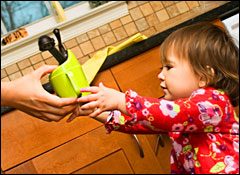Hi Umbra,
What about “sippy” cups for little kids, not to mention bottles? They’re all plastic, and we all know that kids are more vulnerable to environmental toxins. What’s a mom to do?
Janet Byron
Berkeley, Calif.
Dearest Janet,
A mom is to check the research and purchase only bottles and sippy cups that are not considered health hazards. Umbra is to help the mom do so right now in this very column.

Sip sip … harrumph.
Photo: iStockphoto
There are alternatives to bad plastics, don’t fret. Some of the alternatives are glass, others are less harmful plastics, and aluminum may even be a good choice in some situations.
First, a review: Plastic is a lightweight, reusable material that gained dominance in the kids’ consumer-goods market due to its low cost and durability. Today’s plastics are manufactured using chemical compounds found in petroleum and natural gas, with other chemicals added to achieve desired properties such as flexibility, color, and solidity. Although plastics are undeniably handy and here to stay as part of modern life, they do have environmental drawbacks. Immediate threats to human health from plastic food containers include phthalate softeners and the resin bisphenol A. Dioxins, which result from the manufacture and disposal of polyvinyl plastic, have been identified as a major long-term threat to the environment and mammal health. Children, as you say, are small and grow rapidly, chewing everything in sight for part of their life, and are hence at a higher risk from plastic food containers than we ginormous adults.
Both phthalates and bisphenol A are considered hormone disruptors. Bisphenol A may be acting as an estrogen substitute within our bodies and those of our children, causing abnormal development of various organs including the brain and reproductive system. Bisphenol A has been in the news recently as regards baby bottles because of a study released by Environment California that found BPA in the five most popular polycarbonate baby bottles. (Reading that report is probably the best way to absorb all the various impacts potentially attributed to bisphenol A in plastics.) Then the National Institutes of Health picked the whole thing up to examine what’s happening, and that seems to be ongoing. Phthalates I’ve discussed before on numerous occasions; they are also chemicals that are added to and leach out of plastics and can then perhaps disrupt our reproductive systems. Bad, the whole thing is bad.
We as consumers can act now, however, and just throw out all our polycarbonate and vinyl bottles (the ones with the numbers three and seven within the recycling symbol) and replace them with better things. What better things? Wouldn’t a shopping list be handy? Why look! Here are two: Environment California has a shopping guide with good general tips for how to avoid these plastics. And the second, a “Smart Plastics Guide” from the Minnesota-based Institute for Agriculture and Trade Policy, lists the actual bottles and sippy cups to avoid and those that are OK to buy. Both documents outline the basic trouble with toxics leaching out of plastics, and would be good reading for parents and others who have more interest. I find them quite motivating, almost terrifying, definitely depressing; we have poisoned our entire world, and I am unable to summon a closing quip.
Sullenly,
Umbra

